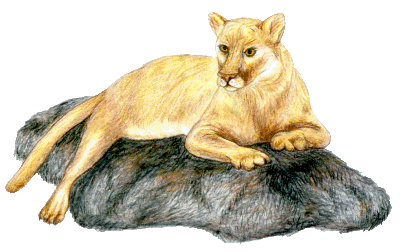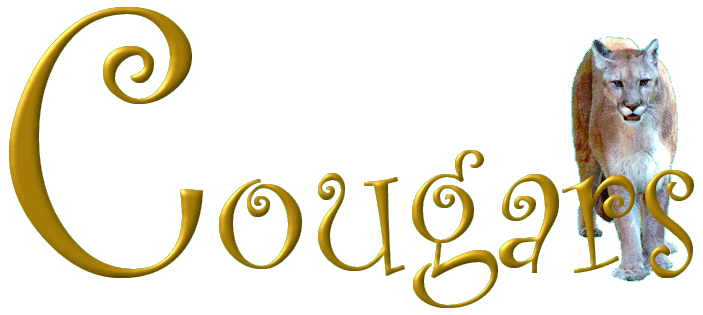Cougars are known by many names but are seen by few. Call them pumas, mountain lions, catamounts or panthers. They are one and the same animal - Felis Concolor. They are highly adaptable, and are found from cold mountain forests to tropical forests to pampas to the fringes of the desert. The eastern cougar and the Florida panther, as they are commonly called, are endangered.
 Cougars once roamed from British Columbia in Canada to middle South America including most of the United States. Though now are mainly found in western North America to South America, and in a small area in Florida.
Males and females live separately, except for breeding. Though they breed in different seasons, cougars in their northern-most range breed mainly in winter and early spring. After a 90 day gestation, females give birth to 1 to 6 cubs. The female generally gives birth in a cave or under a rocky ledge. Cubs are spotted, but their coats give way to a russet or tan color, hence the species name - concolor - which means "uniform color". Cubs stay with only their mothers, the fathers are not involved in raising them. Young cougars will stay in a home den while their mother hunts. She will bring them meat, as well as give them milk. Between 18 and 22 months, she will teach them to hunt. Though they have inborn predatory instincts, they must learn to hunt from their mother. After they learn this, they become fully independent.
Cougars once roamed from British Columbia in Canada to middle South America including most of the United States. Though now are mainly found in western North America to South America, and in a small area in Florida.
Males and females live separately, except for breeding. Though they breed in different seasons, cougars in their northern-most range breed mainly in winter and early spring. After a 90 day gestation, females give birth to 1 to 6 cubs. The female generally gives birth in a cave or under a rocky ledge. Cubs are spotted, but their coats give way to a russet or tan color, hence the species name - concolor - which means "uniform color". Cubs stay with only their mothers, the fathers are not involved in raising them. Young cougars will stay in a home den while their mother hunts. She will bring them meat, as well as give them milk. Between 18 and 22 months, she will teach them to hunt. Though they have inborn predatory instincts, they must learn to hunt from their mother. After they learn this, they become fully independent.
 Males are solitary and territorial. They will hunt any size animal, but usually prefer medium-sized animals such as deer. They can kill an animal as large as an elk (5 to 6 times a cougar's weight). Though the elk's neck muscles (cougars kill by suffocation) are too thick for a cougar's bite to be fatal, they use their forelimbs to twist and snap the elk's neck.
Males are solitary and territorial. They will hunt any size animal, but usually prefer medium-sized animals such as deer. They can kill an animal as large as an elk (5 to 6 times a cougar's weight). Though the elk's neck muscles (cougars kill by suffocation) are too thick for a cougar's bite to be fatal, they use their forelimbs to twist and snap the elk's neck.
Even if you live where you could have heard a cougar,you might not have known that's what it was. The sound a cougar makes is similar to a house cat, but louder. It is high pitched. They make a set of whistlelike sounds - studied in captive cougars - which may be used by wild pairs or in families to call and warn each other.
Cougars or "Painters" as they are known in this area, were at a species low before European man even arrived.  They rely on a variety of prey, including large mammals and as those animals - including buffalo, deer, elk and others- disappeared from eastern America, the population declined. Add in the encroachment of man and the open shooting of panthers as a nuisance led to their disappearance in this area in the late 1800's to early 1900's according to scientists. But this may not be totally true. I know of at least three people who have seen a big cat in the woods in the area. Proof? Trust of word is the best I can do. Though one sighting was in the mid 1900's, though that is even after scientists have declared the cougar gone from this area. The other two reports are within the last ten years. Both were in remote back areas on private land. One was told to me of a big, dead cat. But who would drag a several days old dead cat through the mountains to prove it, when you only want the area to stay as it is and privacy is better than
They rely on a variety of prey, including large mammals and as those animals - including buffalo, deer, elk and others- disappeared from eastern America, the population declined. Add in the encroachment of man and the open shooting of panthers as a nuisance led to their disappearance in this area in the late 1800's to early 1900's according to scientists. But this may not be totally true. I know of at least three people who have seen a big cat in the woods in the area. Proof? Trust of word is the best I can do. Though one sighting was in the mid 1900's, though that is even after scientists have declared the cougar gone from this area. The other two reports are within the last ten years. Both were in remote back areas on private land. One was told to me of a big, dead cat. But who would drag a several days old dead cat through the mountains to prove it, when you only want the area to stay as it is and privacy is better than  publicity for that. Hikers report of them in the Great Smoky Mountains park, but rangers say they have never seen any proof in ways of tracks, droppings, or fur. Well, even in this most visited National Park in the country, the backcountry is incredibly hard to navigate due to heavy undergrowth. Currently underway in this park is a counting of all the species of life, and they have found new species of many things in this past year. So who knows? Also it is reported likely that some cougars could have been turned loose that were kept as pets till they became difficult. But these cougars would not be native cougars. Bobcats do live in the area, but they are no where near the size of a cougar. I have seen fur and droppings from Bobcats around the area in which I live.
publicity for that. Hikers report of them in the Great Smoky Mountains park, but rangers say they have never seen any proof in ways of tracks, droppings, or fur. Well, even in this most visited National Park in the country, the backcountry is incredibly hard to navigate due to heavy undergrowth. Currently underway in this park is a counting of all the species of life, and they have found new species of many things in this past year. So who knows? Also it is reported likely that some cougars could have been turned loose that were kept as pets till they became difficult. But these cougars would not be native cougars. Bobcats do live in the area, but they are no where near the size of a cougar. I have seen fur and droppings from Bobcats around the area in which I live.
The following photos were taken by me or my daughter, Christy, who is pictured in the first photo. She works some at the Western North Carolina Nature Center, which has two cougars in their cougar habitat. The cougars in these photographs are named Val and Satch. I think she is really lucky to work with them.

